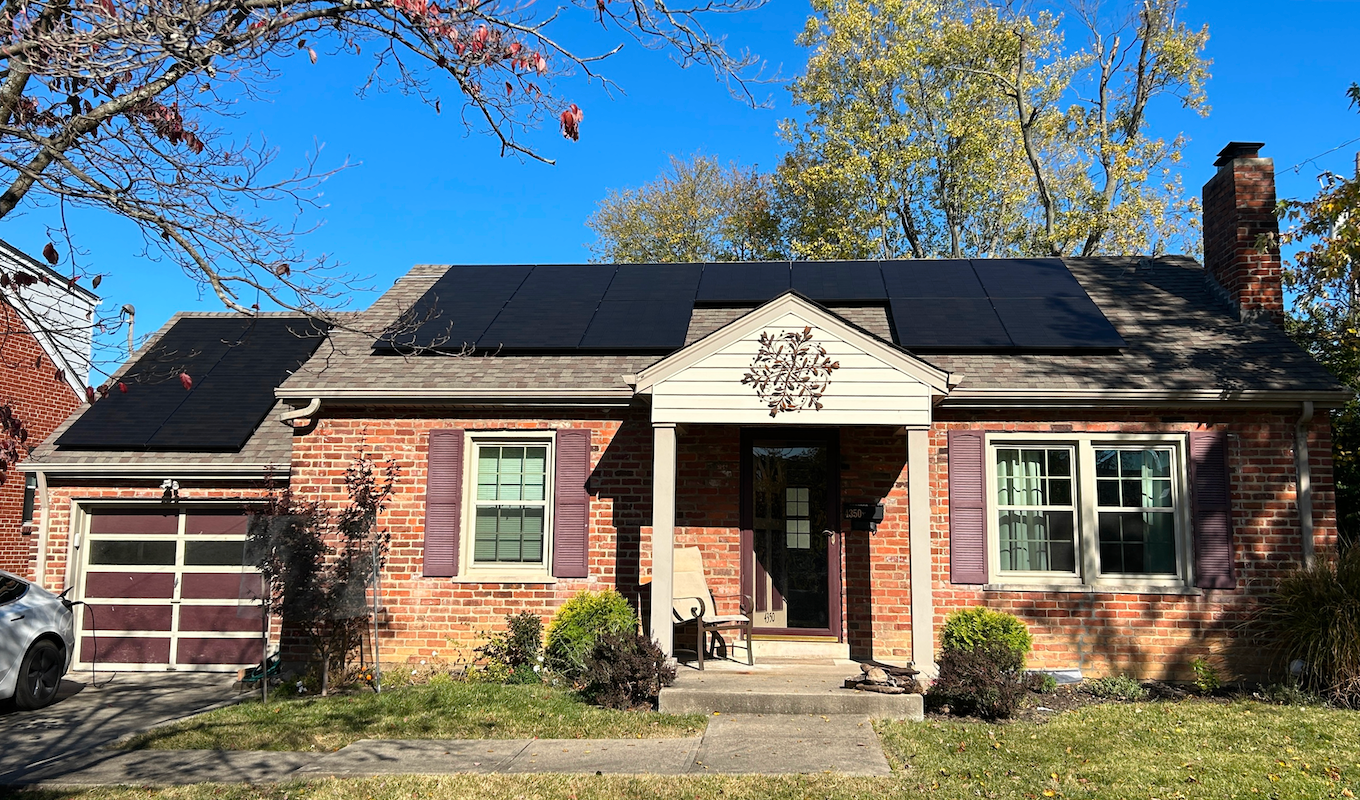After years in the works, my Solar Array got the final “Permission to Operate” from Duke Energy to go online on November 18th, 2024. This is a brief overview of my DIY residential solar project in Deer Park, OH (Cincinnati area).
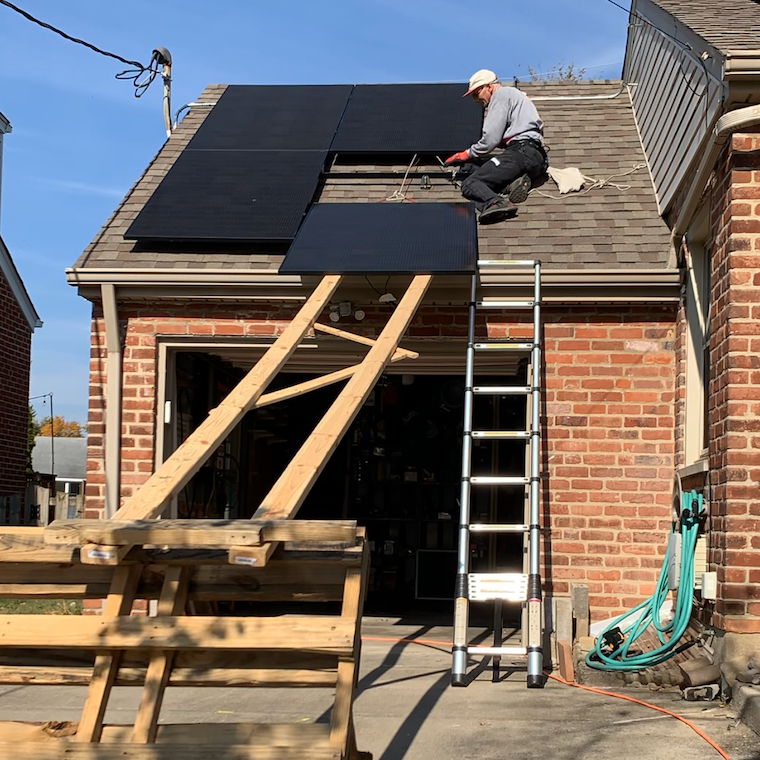
This solar installation was a complete DIY project. I planned, designed, purchased, and installed every bolt, rail, breaker, circuit, inverter, and solar panel. I reviewed the electrical code and the fire code. I dealt with building and electrical permits. I installed a safety harness system on my roof. I dealt with Duke Energy to grid-tie this system. Okay, I did get a few hours of help from my son to install a few of the panels. But, the majority of the panels were hoisted to the roof by myself up a custom-built ramp.
DIY a good choice? Success or failure?
Since my initial purchase of this house in the Fall of 2019, installing solar panels has been a significant part of my plan to make it a “net-zero” energy house. For over a year, I debated between going a DIY route and having a commercial company do this installation. I love doing DIY work. I love saving money. At my prior home, I installed a residential solar system where I was the “general contractor,” with responsibility for everything except the final installation. This project should be well within my capabilities.
The biggest issue with DIY solar is the regulatory side. In the US, building regulation is a complex affair, with local, state, and national regulations needing to be considered. The local agencies will be the primary point of contact, but they are influenced by and subject to the broader agencies. And with very few DIY examples, it is pretty unknown what a DIY person will need to do to complete the project. And the requirements and hurdles will vary greatly from place to place. This makes a DIY solar project much more challenging than it might otherwise be.
My decision to go the DIY route was made because I wanted to make it easier for others to make this decision in the future. I wanted to create the documentation and information I wish was available for DIY people.
This article is the start of creating the Solar DIY resource for others in a similar situation to me.
So, the success of this project will need to be realized as I create more online resources for others. If you are reading this and have a similar DIY project in mind, then I’m happy. Below are additional discussions of some more common metrics of success.
As with any project, there is the question of how well the system will hold up over time. To actually answer this, we need to wait. I did use some newer micro-inverters (Hoymiles) that are not the industry standard. These Hoymiles inverters actually enabled some of the lower costs both directly and because they allowed for a simpler electrical design.
Does the system work?
The solar array is installed, grid-tied, and generating power as expected. It looks great. The technical implementation is top-shelf, should be trouble-free for a long time, and continue to pay me back, possibly for the rest of my life!
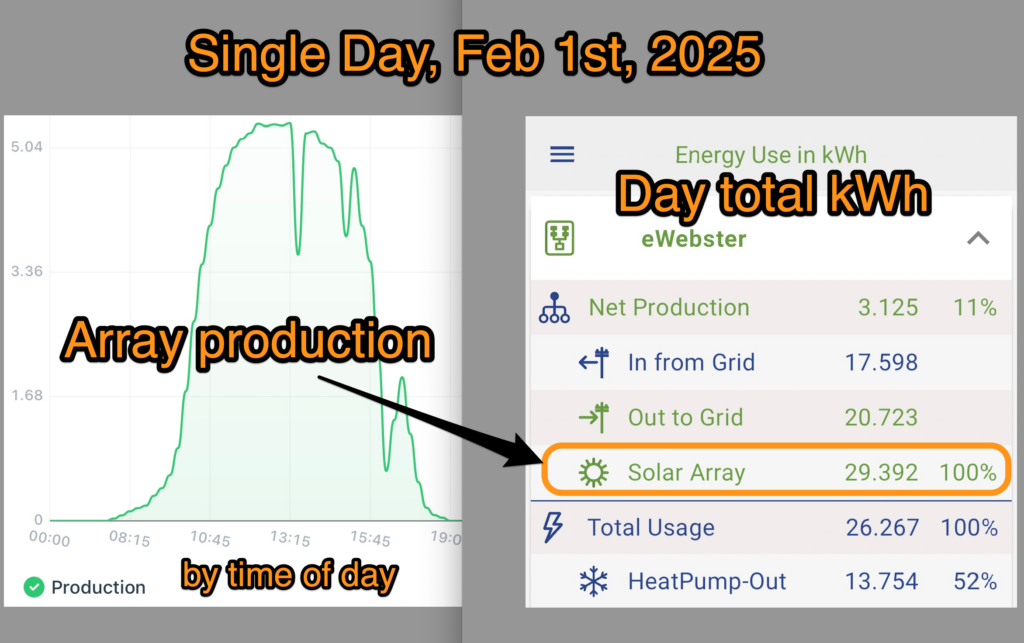
So, does it work? Absolutely, running perfectly!
See the graphic showing the solar production on February 1st, 2025, a mostly sunny and cool day. The array was able to produce almost 30 kWatt-Hours of energy. That was more than enough to completely power my house even with the temperatures running 27 – 41 ℉.
Please see my other posts, where I will detail the energy generation in more detail.
Was the installation cost-effective?
The total cost of this installation was $9,024. This calculates to $1.39/watt all-in before any incentives or rebates. I will detail these costs in a later posting, but the breakdown was roughly four equal buckets: panels (25%), inverters (25%), mounting hardware and electrical parts (25%), and documents, permits, tools, safety items, and misc (25%).
I qualify for a 30% tax credit in the US, so my final cost after incentives is $6,317 or $0.97/watt.
🌞 $0.97/W 😳
The commercial bids from highly reputable established installers in 2023 were about $3.50/watt. In 2024, I saw lower quotes, even a bit under $3/watt, but I did not pursue and get specific quotes for my project in that time frame.
So, if you ignore that I had free labor, I completed this project at better than HALF COST of what a commercial install would have cost. I also think that my installation might be BETTER and have MORE features than a commercial project. Without a real comparison, this is impossible to say. I just know that I am a stickler for details and do not accept compromises. Here are some of my implementation details where I went beyond what a commercial installation might have done:
- Aesthetics: The visual appearance of the solar array was a critical design element. This included the black panels with matching black frames and hidden end attachments. This also includes careful consideration of the conduit bending, routing, and integration.
- Panel Layout: The specific locations of the panels were selected to meet the fire code requirements of setbacks while minimizing the expected shading. The required access paths were placed in the areas that had the most shading.
- Simplicity and component selection: This system is designed to maximize a SINGLE TRUNK line. It took a very specific selection of panels and inverters to make this possible.
- Maximize System Monitoring: This system has 3 performance monitoring systems. There is a simple lifetime solar generation monitor electric kW-Hr meter in my garage. The inverters include their own integrated online monitoring system. Most importantly, I included an incredible Emporia electric panel circuit monitoring as well.
- Designed for Performance and Serviceability: The panels are raised off the roof the maximum distance to improve airflow for cooling which will improve operation. The micro-inverter locations also took into mind airflow for cooling. The installation location of the roof-top junction boxes and micro-inverters was made such that they could be easily accessed in the case of a failure.
- Selective Tree trimming: Very selective trimming was done on the trees to the East side of this array. The goal is to decrease the morning shading but not to the extent of compromising the aesthetics of my lot.
Do I recommend residential solar as a DIY project?
The top-level cost analysis makes my DIY work look like a very attractive alternative. The calculated costs do not include anything for labor, that is all my time. I spent countless hours designing and optimizing my system based on the availability of inexpensive components that would optimally cover my available roof and meet all regulations and fire codes. The installation was extremely slow and arduous, requiring hours of investigation into building and electrical codes and making decisions to optimize my system. Even the stress of knowing that inspectors could completely derail my project was pretty intense.
In the end, I would only recommend this as a DIY project for the most ambitious DIYers!
To complete this project, it took an enormous amount of effort. I like to optimize all my decisions. I wanted the best possible implementation. There are so many options for panels, inverters, and attachment hardware. A commercial solar company will already have optimized the majority of these selections and only use something different if it is really required. The electric code by itself can get pretty complicated and when you add in the newness of a solar installation, it gets even more complicated. Local install companies will be familiar with the ins and outs of the local regulator agencies.
In subsequent articles, I will show more details about this installation. I'd really love to see more people moving towards a sustainable future. Our lives depend on it.
There are fantastic solar installation companies out there (see info on Kokosing Solar below), but there are FAR MORE sub-standard, “fly-by-night” charlatans! Be very careful in selecting a commercial installer. If they are pushing financing, RUN AWAY! Only deal with well-established and verified professionals.
In Summary: My solar system is Great!
Prior to moving forward with this project, I had been thinking about solar and working alternatives for a very long time. In the Fall of 2024, I pulled the trigger, paid for a professional layout of my project documentation, opened permits, and purchased materials. This project consumed me for most of that Fall!
Looking back, here is the mock-up (1st image) of what I expected the panels to look like when completed compared to the actual results (2nd image).
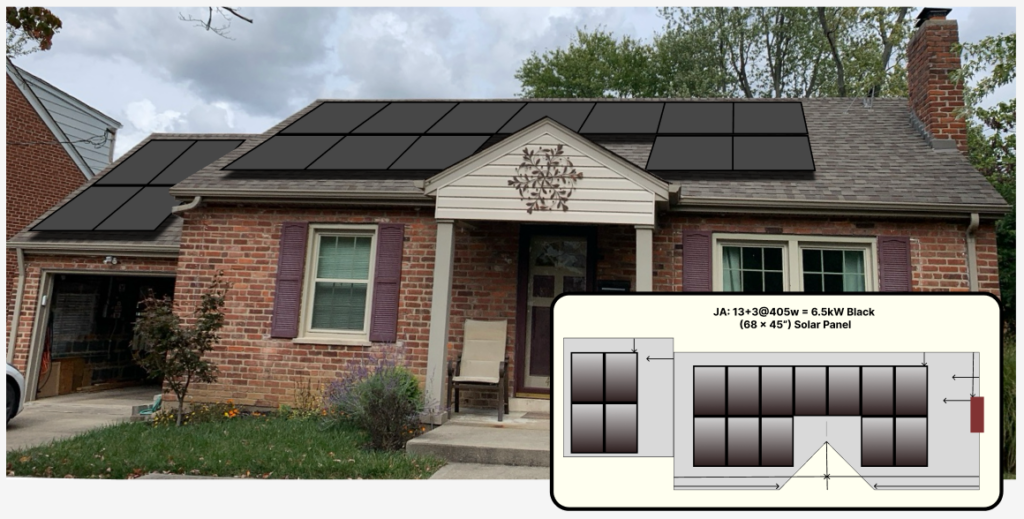
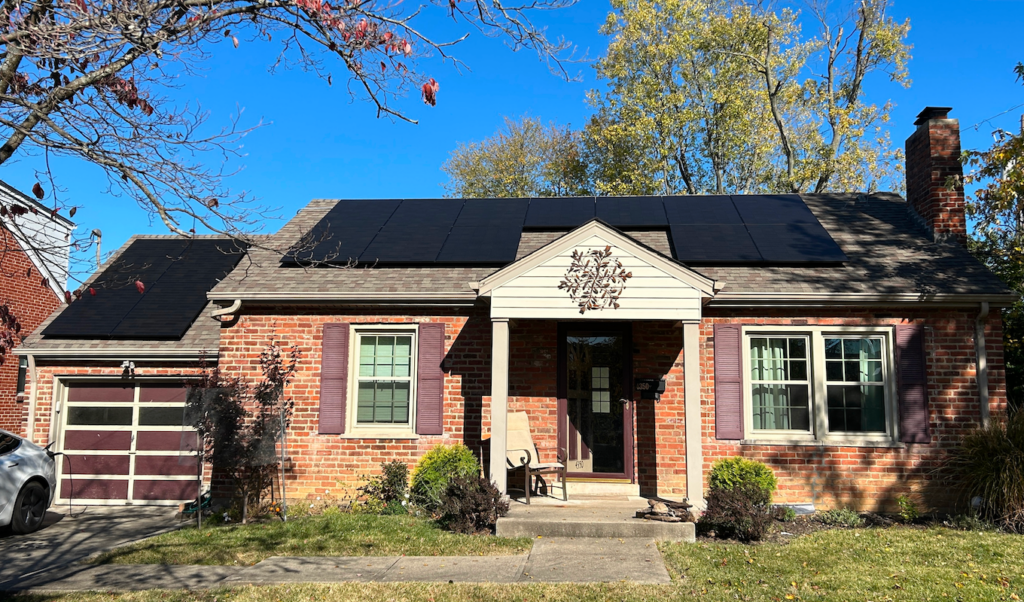
It is pretty cool to see that I was able to create a concept and see it through!
Special Thanks
This was my biggest DIY project ever, and I am old enough that this might be my final larger-scale DIY project. In the future, I look forward to engaging more with the excellent professionals that exist out there to help homeowners. Below is a quick callout to some companies that contributed in some way to the success of this project:
- Environmentalist Everywhere: The fact that others have paved the way because of their concern for the future of our planet is by far the biggest contributing factor. This is SO broad, but at its core is individuals who care. I thank you all!
- Kokosing Solar: If I had chosen to do a commercial install, I would have gone with Kokosing Solar. When John Miller met with me and created a proposal for my project, I was SO PLEASED with his knowledge and lack of BS. And he was backed by a large and reputable company with an excellent track record of success. And with all this, they were still price-competitive!
- Sustainergy: I was so excited to hear about and talk to Sustainergy, an employee-owned cooperative in the Cincinnati area, focusing on the broader picture of energy efficiency. It is not just about slapping solar panels on a house. These people get it and live it. I love talking to knowledgeable people.
- NC Solar Electric LLC: I bought my micro-inverters and associated accessories from Todd Desiato at NC Solar. He is building an amazing solar business in North Carolina and online. He is an industry expert, and you will see him active on Internet forums like DIY Solar Forum, helping a lot of DIY people with their solar installations. He was a critical piece in me being able to complete this project as I desired with these newer less known, but arguably better, Hoymiles micro-inverters. He was super responsive to all my questions and needs, and his prices are excellent.
- RES Supply: I looked at lots of different options for purchasing my panels and attachment hardware. In the end, I went with RES Supply for both. Their website is excellent! Their communication is top-notch. They have lots of distribution centers. I did have a bit of SNAFU where they asked me to pay additional for shipping beyond what the website had quoted me at the time of order. I realize that this was because I was making a relatively small order and buying clearance items resulting in my order being at a net loss for them. I appreciate their willingness to do business with small operations like mine, and even with the additional charge, I got a fantastic deal. I absolutely give them my highest recommendation as a solar supplier.
- Iron Ridge: Anyone in the solar market knows Iron Ridge and their mounting hardware. They have continued to innovate and have excellent design tools available. These tools make using their components extremely easy with little chance of missing needed hardware.
- Inspectors at Deer Park and Cincinnati Inspection Bureau Inc: Contractors and inspectors are often at odds with each other. I have worked on multiple DIY projects with permits from my local building and electric inspectors. They have always been responsive, reasonable, and respectful. On a project like this solar installation, they do not have a lot of experience but do know the critical elements. I went into this project trying to be an expert in all areas so there would be no issues.
- I do wish that there were local inspection agencies that would be willing to work in a more proactive nature. I know that this is generally not feasible. They can be understaffed and overworked and not have time to give advice on projects prior to their start.
Thank you for reading!
